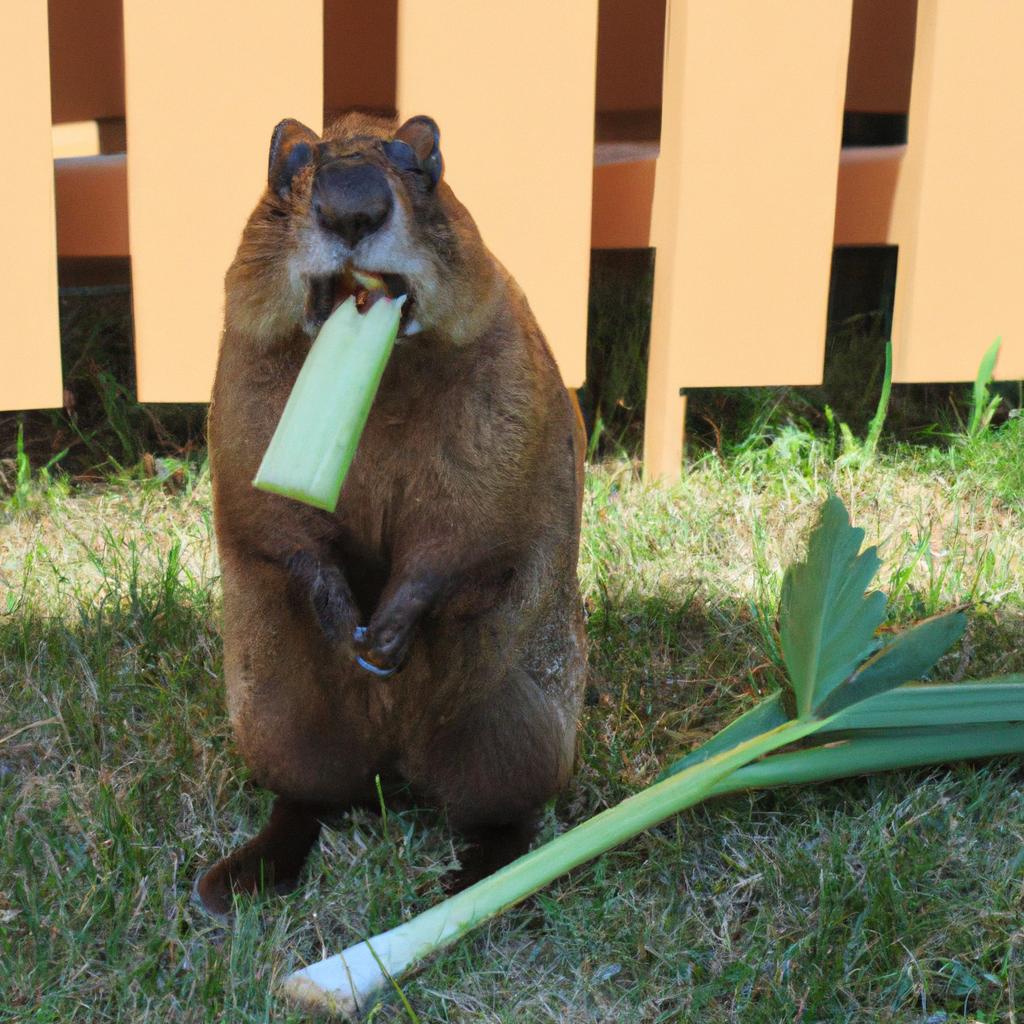As a backyard owner, I’ve always been interested in the various animals that visit or live on my property.
I’ve seen many creatures come and go, and I’ve always been fascinated by the ways they interact with the environment and their food choices.
One animal that has piqued my curiosity is the groundhog.
These furry creatures are known for their burrowing habits and their voracious appetite for plants, but do groundhogs eat celery?
The answer is yes, groundhogs do eat celery.
Let’s dive deeper into the world of groundhogs and their dietary preferences.
Contents
Groundhogs: A brief overview
Groundhogs, also known as woodchucks or whistle pigs, are large rodents belonging to the marmot family. They are native to North America and can be found in regions with abundant grasslands and forests.

Groundhogs are known for their burrowing habits, as they create extensive tunnel systems to live in and escape from predators. These burrows can be quite intricate, with multiple entrances, exits, and chambers for sleeping and raising their young.
Groundhog diet: What do they eat?
Groundhogs are primarily herbivores, meaning they feed on a variety of plants.
Their diet consists mainly of:
1.Grasses:Groundhogs eat various grasses, which make up a significant portion of their diet.
2.Leaves:They will also consume the leaves of plants, including those of trees and shrubs.
3.Fruits and vegetables:Groundhogs enjoy fruits and vegetables, such as apples, berries, and yes, celery.
4.Flowers:They have been known to munch on the petals of various flowers, including sunflowers and dandelions.
In addition to these food sources, groundhogs may also consume insects and other small animals if the opportunity arises.
However, this is not their primary source of sustenance.
When do groundhogs eat celery?
Groundhogs eat celery when it is available and accessible.
This could be during the spring and summer months when people are growing celery in their gardens, or when it has been discarded in compost piles.
They may also eat wild celery, which grows in some areas of North America.
How do groundhogs eat celery?
Groundhogs have sharp incisors, which they use to efficiently bite off pieces of celery.
They will typically eat both the leaves and the stalks, as both parts of the celery plant provide nutrients.
How often do groundhogs eat celery?
The frequency with which groundhogs eat celery will depend on its availability. If celery is abundant in their environment, they may consume it more frequently.
However, their diet is varied, and they will also eat other plants as they become available.
Why do groundhogs eat celery?
Groundhogs eat celery because it provides essential nutrients, such as vitamins and minerals. Celery is a good source of vitamin K, vitamin C, and potassium, which are all important for maintaining good health.
Additionally, the high water content in celery can help keep groundhogs hydrated during the warm summer months.
Implications for backyard owners
If you have a garden with celery, you may find that groundhogs are attracted to it. While they can be a nuisance due to their burrowing habits and their appetite for garden plants, it’s important to remember that groundhogs are a natural part of the ecosystem.
As long as they are not causing significant damage to your property, it may be best to accept their presence and take steps to protect your celery and other plants, such as installing a fence around your garden.
Other animals that eat celery
Groundhogs are not the only animals that enjoy feasting on celery. Other creatures that may eat celery include:
- Deer
- Rabbits
- Squirrels
- Various species of birds
It’s important to remember that many animals play a crucial role in maintaining a healthy ecosystem, and their diet preferences can be a reflection of that.
How To Keep Groundhogs Out Of Your Yard!
There are several things that can be done to prevent groundhogs from digging and eating stuff in your backyard. I will list some of the strategies below.
Also, see my recent post if you want a full list of my favorite methods to keep groundhogs and gophers away!
1. Using ultrasonic sound
Groundhogs, like other bigger mammals that may invade your garden, tend to have very good hearing. This means that loud or consistent noises will scare them away or at least shorten their visits.
Check out my full buying guide for these ingenious ultrasonic repeller devices here!
One of my favorite technologies to keep pests away from my backyard is these cool solar-powered ultrasonic sound emitters that you can buy right from Amazon! In my experience, they really work, and the solar panels on top save you the time and money of changing batteries all the time.
They will also work against other rodents like gophers, mice, and rats!
2. Sprinkling natural repellents
Groundhogs may be scared off by using natural scents such as coyote urine or predator scents.
They may also cause them to leave if there is a combination of sounds being played from a radio. The sounds include the sound of barking dogs and coyotes.
You can sprinkle dog hair, cayenne pepper or strong enteric oils and other natural repellents around the garden to keep the groundhogs away.
See my complete list of humane ways to keep groundhogs away from your yard for more tips and tricks!
3. Fencing around the garden
You can also fence around your garden to keep groundhogs from entering the garden. It should be at least 3 feet deep and have a double row of fencing.
Groundhogs are good diggers so it has to go underground or they may find a way into the garden even with the fences in place!
4. Using live traps
You can use a live trap to capture groundhogs and move them to another area. Live trapping is currently the most humane way of groundhog control. Once you have removed all groundhogs from an area, it is important to ensure that they do not come back by using fencing or other barriers to block access.
You can also just buy a live trap, as the sturdy metal ones shown here:
To lure the groundhogs in, you can use one of the numerous favorite foods of groundhogs or an optimized extra attractive formula like this one to make the catch even quicker!
5. Using natural pesticides
There are pesticides or rodent toxins that can be used to kill groundhogs on your property. These may also affect other animals in the area so it is important to ensure that they are only sprayed on the targeted plants.
I do not recommend these, as I prefer more humane ways as described here. Also, anything that kills an animal will also harm humans to some degree, so go for a repellant rather than a toxin if you go the chemical route!
6. Using Scarecrows
You can use a scarecrow in your garden to keep groundhogs away. Groundhogs are afraid of novelty so time-sensitive or motion-activated scarecrows may also be effective in keeping them out of the garden.
7. Using Lights
Groundhogs are not strictly nocturnal animals but they are most active at low light so they do avoid areas with bright lights.
Motion-activated lights, sounds, and sprinklers may help prevent groundhogs from entering your yard.
Any blinking light will confuse and scare away groundhogs from your yard, especially if they are motion activated and sudden!
8. Motion-activated sprinklers
Like most animals, groundhogs hate surprises, and they will run away if suddenly sprayed with water. I like this solution because it is humane, simple, effective, and does not require much time to set up.
The Havahart 5277 is a motion-activated sprinkler that is activated by the movement of animals up to 25 feet away and sprays them with a harmless water jet, frightening them off and keeping them at bay.
The included metal stake makes it easy to install in your garden, and the sprinkler can be rotated 180 degrees for maximum coverage.
## Conclusion
In conclusion, groundhogs do eat celery, along with a variety of other plants. As backyard owners, it’s important to understand the dietary habits of the animals that share our environment and to take steps to coexist peacefully with them.
While groundhogs and other creatures may enjoy snacking on our gardens, they are also an essential part of the natural world, and their presence can be a sign of a healthy ecosystem.















